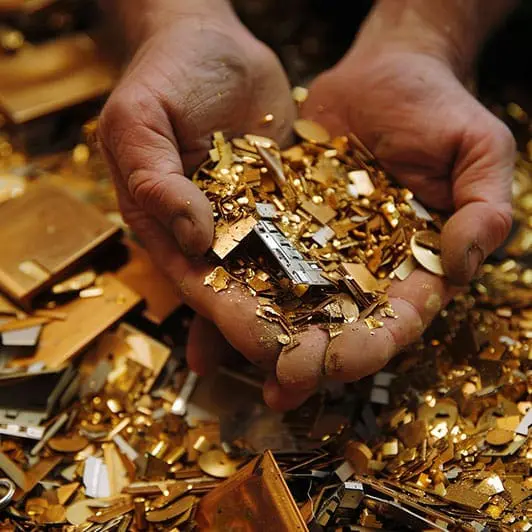ETH Zurich researchers have reported discovering an effective method for recovering gold from e-waste with the help of byproducts from the cheesemaking process.
Protein Fibre Sponge
The group of researchers, led by ETH Professor Mezzenga, have reported using a sponge made from a protein matrix (a cheesemaking byproduct) to extract gold from e-waste.
The protein matrix/protein fibre sponge was made by denaturing whey proteins under acidic conditions and high temperatures, thereby aggregating them into protein nanofibrils in a gel. The gel was then dried to create the protein fibre sponge.
The Process
To test the protein fibre sponge, the research team salvaged 20 old computer motherboards and extracted the metal parts. They then dissolved the parts in an acid bath to ionise the metals. The protein fibre sponge was then placed in the metal ion solution and the gold ions adhered to the protein fibres.
The final part of the process was to heat the sponge, thereby reducing the gold ions into flakes. These flakes were then melted down to form a gold nugget.
How Much Gold?
The researchers reported making a nugget of around 450 milligrams out of the 20 computer motherboards using this process. The nugget was reported to be 91 percent gold (the remainder being copper), which corresponds to 22 carats.
Not Just Gold
Despite being particularly effective at extracting gold ions, the researchers reported that the process can also be used to extract other metal ions.
How Much Gold In E-Waste?
It’s estimated that 7 per cent of the world’s gold may be currently locked-away in e-waste and that there is 100 times more gold in a tonne of e-waste than in a tonne of gold ore! Also, for every 1 million mobile phone handsets that are recycled, an estimated 35,274 lbs of copper, 772 lbs of silver, 75 lbs of gold, and 33 lbs of palladium can be recovered.
What Does This Mean For Your Business?
The growing pile of e-waste, the fact that in global terms only 20 per cent of e-waste is formally recycled, and that so much of the world’s gold (7 per cent), and other precious metals are locked up in e-waste are huge challenges. This ingenious method for gold recovery developed by the ETH Zurich researchers which uses a cheesemaking byproduct is, therefore, very promising in terms of sustainability.
The fact that it’s also reported to be a cost-effective method (and, therefore commercially viable) is a bonus that could see it being made ready for the market soon. Another benefit of this method is its flexibility, making it useful for extracting gold from industrial waste from microchip manufacturing or from gold-plating processes. It’s understood that the scientists are also eyeing the possibility of manufacturing the protein fibre sponges out of other protein-rich byproducts or waste products from the food industry, thereby potentially widening the scope and perhaps reducing the cost of the process even more.
Although apparently effective, it should be remembered that tackling the world’s e-waste problem needs a much wider approach. For example, creating a circular economy for electronic goods where waste is minimised, resources are maximised, the environment and health are protected, while businesses and developing economies can still meet their demand, would all help. However, there’s still quite a way to go before this can happen.
Some of the actions that could help bring these necessary changes about could include more legislation and having a more digital and connected world to help accelerate progress towards sustainable development goals. This could possibly be achieved through ‘device-as-a-service’ business models, better product tracking and take-back schemes, plus entrepreneurs, investors, academics, business leaders and lawmakers working together helping create a circular economy that really works.
The e-waste challenge is significant, but as the ETH Zurich researchers have shown, innovative yet relatively simple solutions exist and could have a major impact if scaled up.



